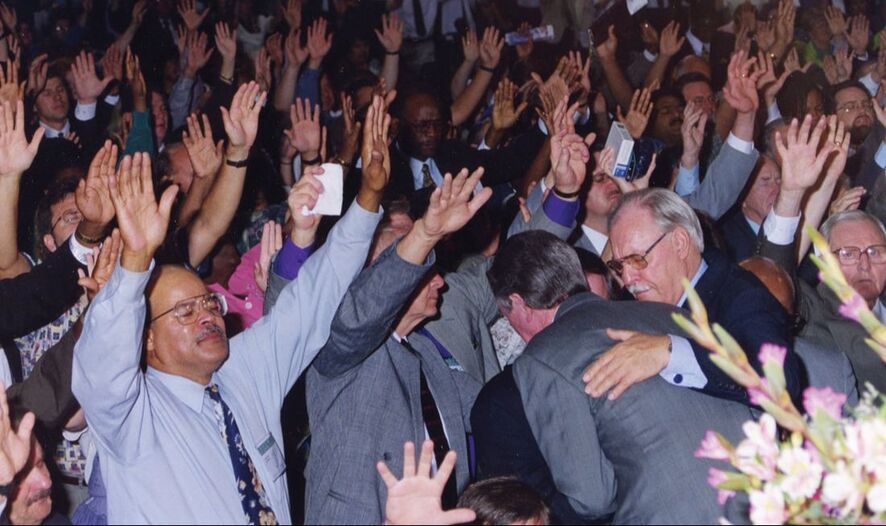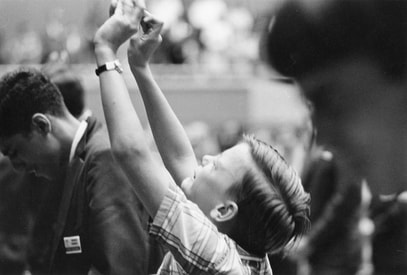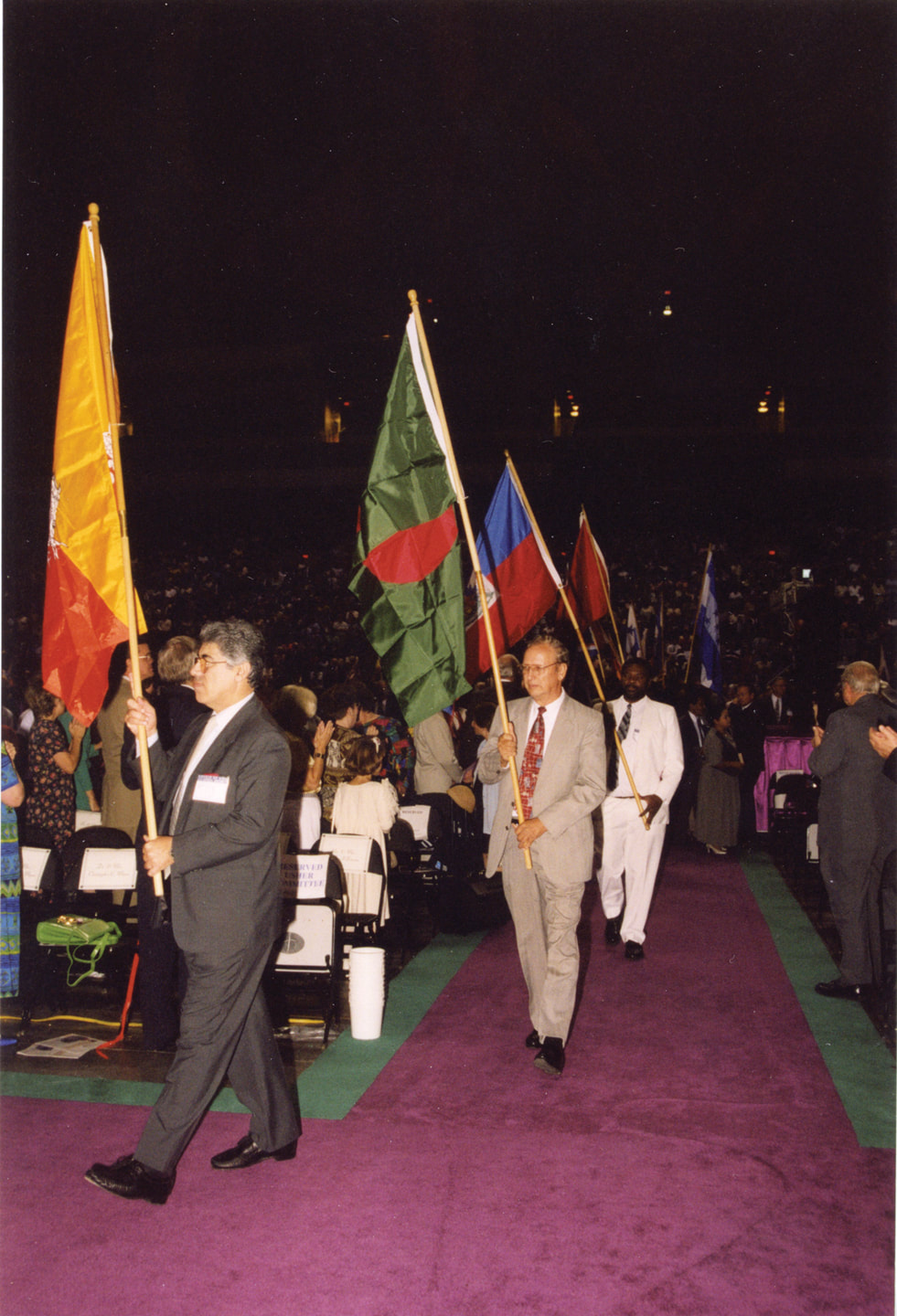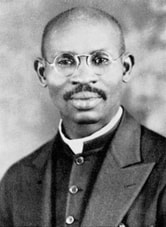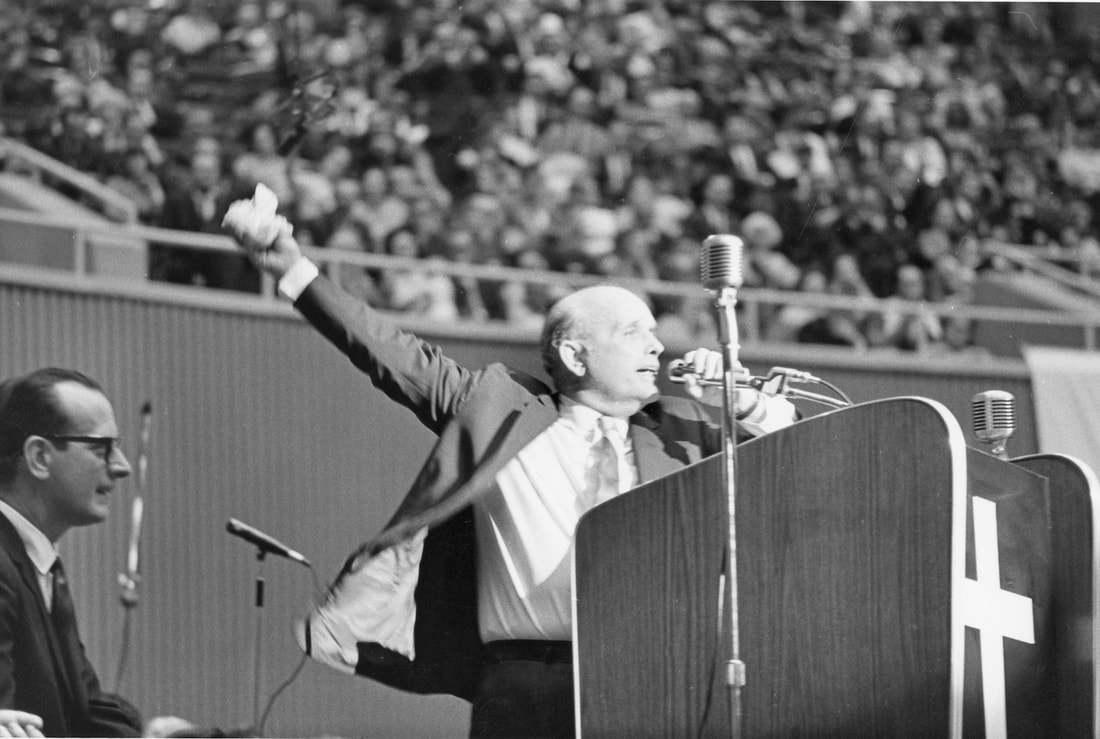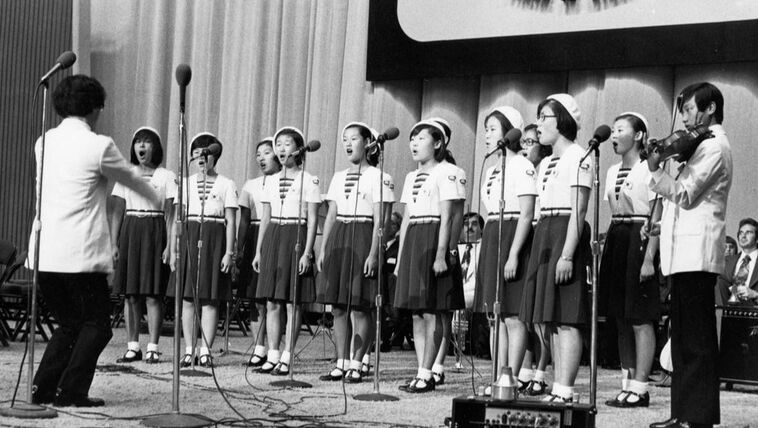WORSHIP AND FELLOWSHIP
Louis F. Morgan
FOR MORE THAN a century, delegates attending General Assembly worship services and fellowship activities have received encouragement, inspiration, affirmation, and confirmation by focusing on Christ and His mission for the Church. Of that first Assembly, A.J. Tomlinson recorded, “The meeting on the whole was noticeable for the love to one another and the unity. Sunday we observed the Sacrament, washing of feet, and this meeting was freighted with the power and presence of the Holy Ghost. Everyone who engaged and most of those who were spectators were bathed in tears showing the sacredness of the occasion” (Diary, January 30, 1906).
Worship and fellowship are dynamic aspects of the General Assembly. Songs, prayers, sermons, testimonies, hugs, and handshakes elicit joyful response to God’s Spirit. “Waves of glory” occur as worshipers respond to the preached Word, anointing singing, and power of the Holy Spirit. Some have responded by running to the altar, while others have shouted and danced in the presence of God. Many will remember Bob Snoderly from Georgia dancing unashamedly in praise. A few may recall when delegates broke out into spontaneous waving of handkerchiefs. It is common for called and spontaneous prayer to fill the auditorium as delegates petition and offer praise to God. Also of importance, meals, receptions, afterglows, early morning coffees, and late night conversations build love and unity among the Church.
Reverend Nora Chambers’ description of the 1932 General Assembly reflects a distinctive of the Church of God—our emphasis on Spirit-filled worship and fellowship: “From the very first service the Lord blessed and His presence, glory and power was with us until the closing of this great gathering. Wave after wave of glory swept over the great congregation, which made us to feel and know that God was with us. There was much shouting and wonderful demonstrations of the Spirit in the praise service…. [S]uch love, unity, harmony and sweet fellowship prevailed” (Evangel, October 22, 1932, p. 1).
In such an atmosphere of worship and fellowship, God does marvelous things. For instance, during the 1919 Assembly, a man came forward who had been unable to walk for 10 years without the aid of crutches, having suffered a broken back and two broken legs. According to the Assembly Minutes, “When they prayed for him the mighty power of God came down upon him, and he was healed, and left his crutches and ran out of the church house and around outside praising God, and the people following him and looking on at the mighty work of God” (A. 1919, p. 44). Often there is special prayer for the sick, and sometimes handkerchiefs have been sent to the Assembly to be prayed over and then returned to the sick. It is expected that people will be healed or receive salvation, sanctification, and the baptism with the Holy Spirit during Assembly services.
Worship and fellowship are dynamic aspects of the General Assembly. Songs, prayers, sermons, testimonies, hugs, and handshakes elicit joyful response to God’s Spirit. “Waves of glory” occur as worshipers respond to the preached Word, anointing singing, and power of the Holy Spirit. Some have responded by running to the altar, while others have shouted and danced in the presence of God. Many will remember Bob Snoderly from Georgia dancing unashamedly in praise. A few may recall when delegates broke out into spontaneous waving of handkerchiefs. It is common for called and spontaneous prayer to fill the auditorium as delegates petition and offer praise to God. Also of importance, meals, receptions, afterglows, early morning coffees, and late night conversations build love and unity among the Church.
Reverend Nora Chambers’ description of the 1932 General Assembly reflects a distinctive of the Church of God—our emphasis on Spirit-filled worship and fellowship: “From the very first service the Lord blessed and His presence, glory and power was with us until the closing of this great gathering. Wave after wave of glory swept over the great congregation, which made us to feel and know that God was with us. There was much shouting and wonderful demonstrations of the Spirit in the praise service…. [S]uch love, unity, harmony and sweet fellowship prevailed” (Evangel, October 22, 1932, p. 1).
In such an atmosphere of worship and fellowship, God does marvelous things. For instance, during the 1919 Assembly, a man came forward who had been unable to walk for 10 years without the aid of crutches, having suffered a broken back and two broken legs. According to the Assembly Minutes, “When they prayed for him the mighty power of God came down upon him, and he was healed, and left his crutches and ran out of the church house and around outside praising God, and the people following him and looking on at the mighty work of God” (A. 1919, p. 44). Often there is special prayer for the sick, and sometimes handkerchiefs have been sent to the Assembly to be prayed over and then returned to the sick. It is expected that people will be healed or receive salvation, sanctification, and the baptism with the Holy Spirit during Assembly services.
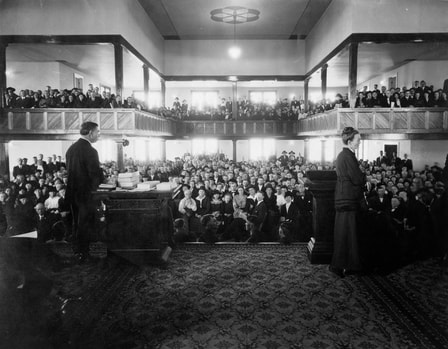 Presenting the orphanage ministry to the General Assembly (ca. 1921),
Presenting the orphanage ministry to the General Assembly (ca. 1921), General Overseer A.J. Tomlinson (left) and Orphanage Matron Lillian
Kinsey (right) invite orphans to the Assembly Auditorium stage
Worship in Music
Music is a distinguishing component of Church of God worship and fellowship. We are a singing church, and the Assembly is a time when we can experience a breadth of talent and styles. Our early Assembly music was brought out of the churches from which the Church of God emerged, and the singing of the Doxology often was incorporated. By the 1920s, we were incorporating songs our own musicians had written. Solos, duets, trios, quartets, and choirs are interspersed throughout the week’s program to provide a worship atmosphere in which our hearts can be sensitive to the Holy Spirit as we endeavored to conduct the business of the Church.
Such worship has provided inspiration for preparing sermons and composing songs. While attending the 1956 Assembly in Memphis, Tennessee, C.S. Grogan completed writing the noted anthem of our Church, “Like a Mighty Army,” which was inspired by Charles W. Conn’s historical account. Grogan, who was pastoring at Roanoke Rapids, North Carolina, reported, “In my prayer room one day, while meditating on the Church and its great program, I began to sing the words that came to be the first stanza of the song…. It seemed quite a coincidence that I finished the song while the General Assembly was in session” (Evangel, February 1, 1960, p. 7). Grogan credited Vep Ellis for encouraging the song’s completion and Edward Williams for arranging the harmony. Under the direction of A.T. Humphries, a group of young men debuted the song during youth night at the 1956 Assembly. Since then, it has been sung in many congregations throughout the world.
Music is a distinguishing component of Church of God worship and fellowship. We are a singing church, and the Assembly is a time when we can experience a breadth of talent and styles. Our early Assembly music was brought out of the churches from which the Church of God emerged, and the singing of the Doxology often was incorporated. By the 1920s, we were incorporating songs our own musicians had written. Solos, duets, trios, quartets, and choirs are interspersed throughout the week’s program to provide a worship atmosphere in which our hearts can be sensitive to the Holy Spirit as we endeavored to conduct the business of the Church.
Such worship has provided inspiration for preparing sermons and composing songs. While attending the 1956 Assembly in Memphis, Tennessee, C.S. Grogan completed writing the noted anthem of our Church, “Like a Mighty Army,” which was inspired by Charles W. Conn’s historical account. Grogan, who was pastoring at Roanoke Rapids, North Carolina, reported, “In my prayer room one day, while meditating on the Church and its great program, I began to sing the words that came to be the first stanza of the song…. It seemed quite a coincidence that I finished the song while the General Assembly was in session” (Evangel, February 1, 1960, p. 7). Grogan credited Vep Ellis for encouraging the song’s completion and Edward Williams for arranging the harmony. Under the direction of A.T. Humphries, a group of young men debuted the song during youth night at the 1956 Assembly. Since then, it has been sung in many congregations throughout the world.
|
|
Louis F. Morgan, Ph.D., is professor and director of Library Services at Lee University.

